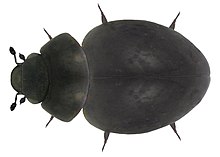| Sphaerius | |
|---|---|

| |
| Sphaerius acaroides | |
| Scientific classification | |
| Domain: | Eukaryota |
| Kingdom: | Animalia |
| Phylum: | Arthropoda |
| Class: | Insecta |
| Order: | Coleoptera |
| Suborder: | Myxophaga |
| Superfamily: | Sphaeriusoidea |
| Family: | Sphaeriusidae Erichson, 1845 |
| Genus: | Sphaerius Waltl, 1838 |
| Species | |
|
see text | |
| Synonyms | |
| |
Sphaerius is a genus of beetles in the family Sphaeriusidae, comprising 18 species. It is one of the two extant genera in the family, the other being Bezesporum. They are typically found along the edges of streams and rivers, where they feed on algae; they occur on all continents except Antarctica. Three species occur in the United States.
The overall form of the beetle is convex, glossy, dark brown or black with some markings possible. The head is prominent, with relatively large eyes set far apart, and capitate antennae. Total length ranges from 0.5–1.2 mm (0.020–0.047 in).
The beetles occur in a variety of damp environments, including mud, under stones, among plant roots and leaf litter, and in mosses in bogs. They store some air underneath their elytra.
Females produce a single large egg at a time.
The family used to be known as "Sphaeriidae", but the name was preoccupied by a family of freshwater clams. The name was inappropriately replaced with "Microsporidae" (by changing the genus name to Microsporus), but this act has been superseded by a return to the use of Sphaerius and a reformation of the family name as Sphaeriusidae.[1] The position of the family within Coleoptera has also changed a number of times.[2]
- ^ ICZN 2000: Opinion 1957. Sphaerius Waltl, 1838 (Insecta, Coleoptera): conserved; and Sphaeriidae Erichson, 1845 (Coleoptera): spelling emended to Sphaeriusidae, so removing the homonymy with Sphaeriidae Deshayes, 1854 (1820) (Mollusca, Bivalvia). Bulletin of zoological nomenclature, 57: 182–184. ISSN 0007-5167 BioStor
- ^ Ross H. Arnett, Jr. and Michael C. Thomas, American Beetles (CRC Press, 2001)